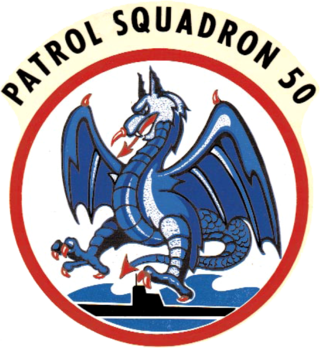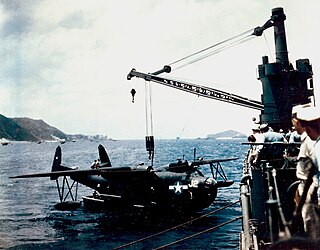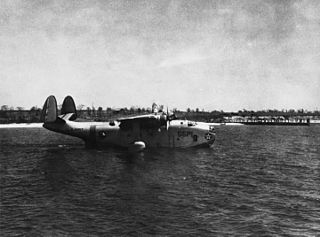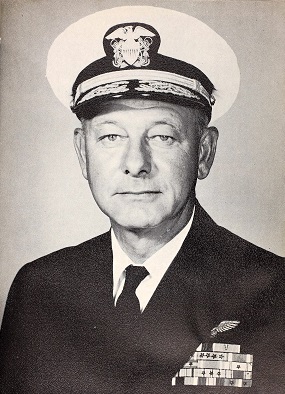Related Research Articles

The Martin PBM Mariner was a twin-engine American patrol bomber flying boat of World War II and the early Cold War era. It was designed to complement the Consolidated PBY Catalina and PB2Y Coronado in service. A total of 1,366 PBMs were built, with the first example flying on February 18, 1939, and the type entering service in September 1940, with the last of the type being retired in 1964.

USS O'Flaherty (DE-340) was a John C. Butler-class destroyer escort built for the United States Navy during World War II. She was named for Ensign Frank Woodrow O'Flaherty, a pilot who posthumously received the Navy Cross for his actions at the Battle of Midway.

Alexander Vraciu was a United States Navy fighter ace, Navy Cross recipient, and Medal of Honor nominee during World War II. At the end of the war, Vraciu ranked fourth among the U.S. Navy's flying aces, with 19 enemy planes downed during flight and 21 destroyed on the ground. After the war, he served as a test pilot and was instrumental in forming the post-war Naval and Marine Air Reserve program. From 1956 to 1958 Vraciu led his own fighter squadron, VF-51, for twenty-two months. He retired from the U.S. Navy with the rank of commander on December 31, 1963. Vraciu later moved to Danville, California, and worked for Wells Fargo.

USS Yakutat (AVP-32) was a United States Navy Barnegat-class small seaplane tender in commission from 1944 to 1946. Yakutat tended seaplanes in combat areas in the Pacific during the latter stages of World War II. After the war, she was in commission in the United States Coast Guard from 1948 to 1971 as the Coast Guard cutter USCGC Yakutat (WAVP-380), later WHEC-380, seeing service in the Vietnam War during her Coast Guard career. Transferred to South Vietnam in 1971, she was commissioned into the Republic of Vietnam Navy as the frigate RVNS Trần Nhật Duật (HQ-03). When South Vietnam collapsed in 1975 at the end of the Vietnam War, she fled to the Philippines, where the Philippine Navy took custody of her and cannibalized her for spare parts until discarding her in 1982.

USS Bering Strait (AVP-34) was a United States Navy Barnegat-class small seaplane tender in commission from 1944 to 1946. She tended seaplanes during World War II in the Pacific in combat areas and earned three battle stars by war's end.

Dumbo was the code name used by the United States Navy during the 1940s and 1950s to signify search and rescue missions, conducted in conjunction with military operations, by long-range aircraft flying over the ocean. The purpose of Dumbo missions was to rescue downed American aviators as well as seamen in distress. Dumbo aircraft were originally land-based heavy bomber aircraft converted to carry an airborne lifeboat to be dropped in the water near survivors. The name "Dumbo" came from Walt Disney's flying elephant, the main character of the animated film Dumbo, appearing in October 1941.

VP-50 was a long-lived Patrol Squadron of the U.S. Navy, having held that designation for 39 years from 1953 to 1992. Its nickname was the Blue Dragons. Originally established as VP-917 on 18 July 1946, redesignated Medium Patrol Squadron (Landplane) VP-ML-67 on 15 November 1946, redesignated VP-892 in February 1950, redesignated VP-50 on 4 February 1953 and disestablished on 30 June 1992.
Fighter Squadron 71 or VF-71 was an aviation unit of the United States Navy. Originally established as VGS-18 on 15 October 1942, it was redesignated VC-18 on 1 March 1943, redesignated as VF-36 on 15 August 1943, redesignated as VF-18 on 5 March 1944, redesignated as VF-7A on 15 November 1946, redesignated as VF-71 on 28 July 1948 and disestablished on 31 March 1959.

Captain Cecil Elwood "Cece" Harris was an American schoolteacher, naval aviator and flying ace of World War II. Harris is remembered for actions in the Pacific Ocean Theater, which earned him nine combat medals including the Navy Cross, the highest award for valor after the Medal of Honor. He ended the war as the navy's second-highest-scoring ace after David McCampbell (34), credited with shooting down 24 Japanese planes. Harris scored 16 of his aerial victories in four different days, downing four enemy aircraft on each of those days. Never during the course of his 88-day tour with VF-18 did a bullet hit his aircraft. It has been said that Harris "was arguably the most consistently exceptional fighter pilot in the US Navy".
VP-44 was a Patrol Squadron of the U.S. Navy. It was established as VP-204 on 15 October 1942, redesignated as Patrol Bombing Squadron VPB-204 on 1 October 1944, redesignated as VP-204 on 15 May 1946, redesignated as VP-MS-4 on 15 November 1946, redesignated as VP-44 on 1 September 1948 and disestablished on 20 January 1950. It was the third squadron to be assigned the VP-44 designation. The first VP-44 had that designation from 1 July 1940 to 6 January 1941. The second VP-44 had that designation from 3 June 1941 to 1 October 1944. A fourth VP-44 was established on 29 January 1951 and disestablished on 28 June 1991.
VP-48 was a Patrol Squadron of the U.S. Navy. It was established as VP-208 on 15 December 1942, redesignated Patrol Bombing Squadron VPB-208 on 1 October 1944, redesignated VP-208 on 15 May 1946, redesignated Medium Patrol Squadron (Seaplane) VP-MS-8 on 15 November 1946, redesignated VP-48 on 1 September 1948 and disestablished on 31 December 1949. It was the first squadron to be assigned the VP-48 designation. A second VP-48 was established in May 1946 and disestablished on 23 May 1991.
VP-25 was a Patrol Squadron of the U.S. Navy. The squadron was established as Patrol Squadron 25 (VP-25) on 20 April 1944, redesignated Patrol Bombing Squadron 25 (VPB-25) on 1 October 1944, redesignated Patrol Squadron 25 (VP-25) on 15 May 1946 and disestablished on 28 June 1946. It was the second squadron to be designated VP-25, the first VP-25 was redesignated VP-23 on 1 August 1941.

VP-26 was a Patrol Squadron of the U.S. Navy. The squadron was established as Patrol Squadron 26 (VP-26) on 1 May 1944, redesignated Patrol Bombing Squadron 26 (VPB-26) on 1 October 1944, redesignated Patrol Squadron 26 (VP-26) on 15 May 1946 and disestablished on 14 December 1946. It was the second squadron to be designated VP-26, the first VP-26 was redesignated VP-14 on 1 July 1941.

VP-40 was a Patrol Squadron of the U.S. Navy. The squadron was established as Patrol Squadron 55 (VP-55) on 1 August 1940, redesignated Patrol Squadron 74 (VP-74) on 1 July 1941, redesignated Patrol Bombing Squadron 74 (VPB-74) on 1 October 1944, redesignated Patrol Squadron 74 (VP-74) on 15 May 1946, redesignated Medium Patrol Squadron (Seaplane) 10 (VP-MS-10) on 15 November 1946, redesignated Patrol Squadron 40 (VP-40) on 1 September 1948 and disestablished on 25 January 1950.

VH-3 was one of six dedicated VH rescue squadrons of the U.S. Navy during WW II. Prior to their creation, the rescue function was performed as an additional "spur of the moment" duty by regularly operating patrol squadrons. The Fleet Commanders made clear "that the men who risked their lives to rocket, bomb, and strafe the enemy wherever and whenever possible, should under no circumstances, be left to fend for themselves when disaster struck them." After the war the Japanese related that they could not understand why so much was risked to save airmen. This was a tremendous morale builder for the flyers, but there was a cold calculated logic behind this as well. It meant that very expensively trained and experienced aviators could be rescued from a watery grave or brutal captivity and put back into the fight. American aircrews captured after being shot down over the Japanese home islands faced a grim fate. VH-3 squadron members related "how intense, intense every crew member became .. over this business of saving lives", "the marvelous feeling of reward when saving a downed pilot's life", and "nose-thumbing at the Japanese military .. when we swiped near-prisoners under their eye".
VH-1 was one of six dedicated (VH) Rescue Squadrons of the U.S. Navy during WWII. VH-1 made 19 direct rescues via open sea landings. It also assisted in the rescue of another 119 air crewman by locating them and directing surface vessels to effect the rescue. VH-1 was established on 1 February 1944 and disestablished in April 1946. The squadron employed the Consolidated PB2Y Coronado and the Martin PBM Mariner during its operations.
VH-4 was one of six dedicated (VH) rescue squadrons of the U.S. Navy during World War II. VH-4 made 42 rescues of downed aviators, nine rescues of Filipino civilians and assisted in the rescue of another aviator. VH-4 was established in September 1944 and disestablished in November1946. The squadron employed the Martin PBM Mariner during its operations.
VH-2 was one of six dedicated Rescue Squadrons of the U.S. Navy during World War II. VH-2 was established in August 1944 and disestablished in November 1945. Unlike the other VH squadrons, VH-2 mostly employed the PB2B Catalina during its wartime operations. Late in the war, the PB2B Catalina was no longer used for open sea rescues, since it had proven less rugged in the open sea than its successor the Martin PBM Mariner. Thus VH-2's primary mission was to "spot" survivors in the water and direct other craft to the site to effect the rescue. On at least two occasions, VH-2 did effect rescues with open sea landings. VH-2 was credited with the initial spotting, direct rescue, or assistance in the rescue of 96 downed bomber crewman. After the war, they were assigned the Martin PBM Mariner.
VH-5 was one of six dedicated Rescue Squadrons of the U.S. Navy during WWII. A more comprehensive write-up on the VH squadrons can be found in the history of Rescue Squadron 3 (VH-3), which was the US Navy's most active VH squadron. VH-5 rescued 8 air crewman, assisted in the rescue another 2 aviators, and assisted in the capture of 4 Japanese adrift on a raft. VH-5 was established in September 1944 and disestablished in June 1946. The squadron employed the Martin PBM Mariner during its operations.

RADM Edward Cobb Outlaw was a naval aviator, flying ace, ship's captain and fleet commander of the United States Navy. Outlaw first served as commanding officer of Fighting Squadron 32 (VF-32) aboard the light carrier USS Langley during World War II. He was awarded the Navy Cross for a mission with this squadron in which he shot down five Japanese planes, making him an ace in a day.
References
- ↑ Gintner, Steve (2013). Martin PBM Mariner (Naval Fighters Number 97). Simi Valley, Ca: Steve Gintner, First Edition. p. 146. ISBN 0989258327.
- ↑ "Page 12 WWII War Diaries" , Fold3, retrieved 2017-01-26
- ↑ "Page 16 WWII War Diaries" , Fold3, retrieved 2017-01-23
- ↑ "Page 60 WWII War Diaries" , Fold3, retrieved 2017-01-26
- ↑ "Page 15 WWII War Diaries" , Fold3, retrieved 2017-01-26